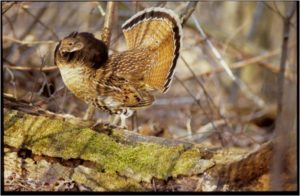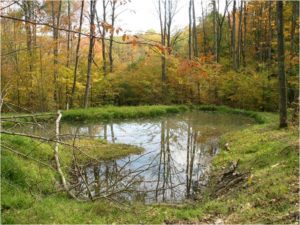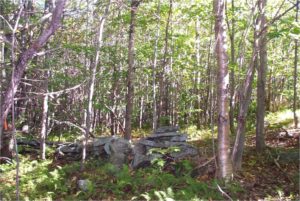Strategies for Managing Your Property for Wildlife
People vary greatly with regards to their preferences for “wildlife”, usually based on their personal experience and interests. For some people, white-tailed deer personify their interest in wildlife. For others, the birds (sparrows, juncos, woodpeckers, and chickadees) they see at their feeders are the most endearing to them. Do we think of the beavers that may have dammed up a stream on our property? Do we think of the huge flocks of Canada Geese that have proliferated in recent years? It can be all of these and many more. NY State is home to a huge variety of wildlife species: 32 amphibians, 39 reptiles, 375 birds, 92 mammals, and 160 freshwater fish.

Ruffed grouse are an indicator species for early succession habitat. If they are present, up to 40 other species of birds and animals will be present. Photo by Cornell University
So when we refer to wildlife we are usually referring to any wild creature that has a backbone, although of course insects too can easily be considered wildlife.
Generally wildlife are thriving across NY State and most of the northeastern US. But several species are not doing so well, and are in danger of becoming imperiled. There are a host of reasons, such as loss of habitat, urbanization, climate change, pollution, and land use changes, or typically a combination of these factors. Of particular concern are species that need early succession habitat, such as open lands, grasslands, and brushy/shrubby habitat. Much of our landscape has grown into mature forests as a result of abandoned farmland. Most of our forests are now considered “mature” or consist of trees that are greater than 12 inches in diameter. Mature forests provide the habitat for certain species of wildlife and those species are typically thriving. But, older forests do not provide the dense understory of brush and other vegetation (often called “early succession” habitat) that are needed by many species.
The key to fostering populations of wildlife is to maintain proper habitat. Habitat provides the four basic components that all species of wildlife need to survive and thrive; food, water, shelter, and space. However, not every single acre of land nor even any one property can be all things to all species of wildlife. It is often best to consider habitat management on a larger, landscape scale where a mix of woodlands, grasslands, shrub lands, wetlands and streams can provide a rich mosaic of habitats for different groups of wildlife.

This vernal pool was created in an afternoon and has provided valuable breeding habitat for many amphibians over the past 2 decades. Photo by Cornell University
Many studies of landowner attitudes and reasons for owning and enjoying rural properties have shown that the ability to see wildlife is a high priority. We find recreation, enjoyment, sustenance, and inspiration from seeing a variety of wildlife on our properties. The question often arises from landowners, “What can I do to encourage wildlife on my property?”
Management will involve adjusting tree species, ages, spacing, and mixes there of. It will take time, money, equipment and expertise to accomplish successfully.
Managing for wildlife may best be done in conjunction with and complementary to other land management activities, such as timber harvesting, firewood cutting, and agriculturally oriented activities. This approach is often called “multiple use”, where several landowner objectives can be simultaneously achieved and more efficiently than focusing on just one objective at a time. Also, managing for “groups” or “guilds” of species that need a specific type of habitat, or maybe even a mix of habitats, rather than just focusing on a specific species, is easier to accomplish.
The following suggestions, in no particular order of importance, are some strategies that can be used to enhance wildlife habitat on a property.

Stone walls are a common relic from past farming practices. This stand of young trees will need to be managed if this valuable early succession habitat is to be preserved. Photo by Cornell University
1. Good forestry and woodlot management can encourage wildlife. Many people believe that cutting trees is bad for wildlife. However, proper forestry, in the form of carefully planned silvicultural activities, such as thinnings, saw log harvesting, and firewood cutting, often with the assistance of a professional forester, can create or improve wildlife habitat. By removing trees of poor sawtimber form and species from a stand, more sunlight will reach the forest floor and encourage the growth of a variety of plants and shrubs which many species of wildlife need. Silviculture is the tending, harvesting, and regeneration of stands of trees, and is not to be confused with the exploitative cutting of trees, such as diameter limit and high grade cutting. This occurs when just the best or most valuable trees are removed from the stand without regard to what is left behind. The future composition and productivity of the forest can be severely limited in this manner.
2. Encouraging early succession habitat can provide critical, but often short-lived habitat that so many species need for their survival. Brush hogging old fields at least every three years can keep an area open. Creating “feathered” edges, rather than “hard” edges will promote early succession species. A feathered edge occurs when an open area blends into a shrubby border which then blends into young trees, before moving into more mature forest. A hard edge is when a field abruptly meets a wooded edge. This effect can foster nest predation by cowbirds, which lay their eggs in other songbird nests. Plus, some wildlife species (such as turkeys and ruffed grouse) benefit from a mix of stands of various ages.
3. Protecting vernal pools and construction of new ones will provide habitat for many species of amphibians in the springtime. A vernal pool is a small, ephemeral body of water which may only be present in the forest in early spring through early summer. However, these pools are critical for the reproductive life cycle for many species of frogs, toads, and salamanders.
4. Protecting wetland and stream habitats is essential for wildlife. Encouraging vegetation to grow along the banks of these habitats and fencing out livestock will protect this crucial habitat component and improve water quality for aquatic species.
5. Den trees, standing dead trees, snags, down logs, and brush piles are collectively known as “coarse woody debris”. This debris provides nesting, perching, denning and feeding sites for many species of wildlife. Nutrients are recycled and important ecological processes are maintained with this debris. Plus tops left in the woods from harvesting trees will protect young seedlings from deer browsing.
6. Tending wild apple trees is good for wildlife. A little pruning, removing competing overhead trees and fertilizing of old apple trees can provide a spike in apple production which provides food for wildlife.
7. Maintaining appropriate populations of white-tailed deer is good for biodiversity. These magnificent animals grace our lives and landscapes, but too many of them in a given area can cause long term ecosystem impacts that can take years to overcome. Tree sapling regeneration and the diversity of plant communities can be negatively impacted when too many deer inhabit an area. Consequently, wildlife species that depend on this diversity of understory cover are negatively impacted. The key method of managing a deer population is through sport hunting where does are harvested in accordance with state wildlife agency regulations.
8. Participating in Woodland Owner Associations will put you in company with likeminded people. Numerous workshops, woods walks, seminars, newsletters and magazines can keep landowners in the information loop. Multiple educational publications and venues are available to interested forest owners. For example, the New York Forest Owner’s Association has ten regional chapters of woodland owners throughout the state.

